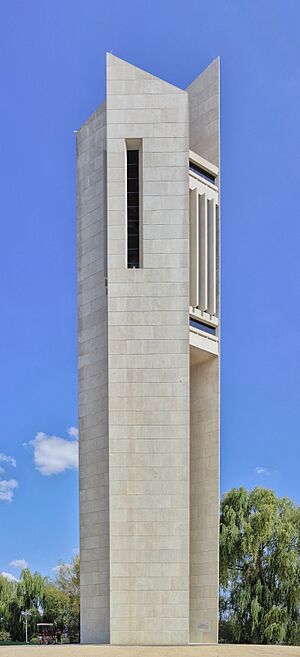National Carillon facts for kids
Quick facts for kids National Carillon |
|
|---|---|

National Carillon in 2016
|
|
| General information | |
| Status | Complete |
| Type | Carillon |
| Architectural style | Brutalist |
| Location | Queen Elizabeth II Island, Lake Burley Griffin, Canberra, Australian Capital Territory |
| Country | Australia |
| Coordinates | 35°17′55″S 149°08′30″E / 35.2985°S 149.1417°E |
| Inaugurated | 26 April 1970 by Elizabeth II |
| Renovated | 2004 |
| Owner | Commonwealth of Australia |
| Landlord | National Capital Authority |
| Height | 50 m (164 ft) |
| Technical details | |
| Material | Concrete |
| Design and construction | |
| Architecture firm | Cameron Chisholm Nicol |
| Other designers | John Taylor & Co (bells) |
| Official name: Carillon, Wendouree Dr, Parkes, ACT, Australia | |
| Type: | Listed place |
| Criteria: | D. and E. |
| Designated: | 22 June 2004 |
| Reference #: | 105346 |
The National Carillon is a tall musical tower located on Queen Elizabeth II Island in Lake Burley Griffin, right in the middle of Canberra, Australia. It's like a giant musical instrument with many bells! The National Capital Authority looks after it for the Australian government. This special carillon has 57 bells. They range from a huge bass bell that weighs over 6,000 kilograms to a tiny treble bell weighing just 8 kilograms.
Contents
A Gift from Britain
The National Carillon was a gift from the British government to Australia. It was given to celebrate Canberra's 50th birthday as the nation's capital. Architects from both Australia and Britain competed to design it. The winning design came from an Australian company called Cameron Chisholm Nicol.
Building the Carillon
The carillon was designed in 1967 and built between 1969 and 1970. Its three tall columns represent the British government, the Australian government, and the city of Canberra. Queen Elizabeth II herself officially opened the National Carillon on April 26, 1970. This tower is a symbol of the strong connection between Britain and Australia. It also marks an important moment in Canberra's history.
The tower stands 50 meters (about 164 feet) tall. The bells and their playing system were made by John Taylor & Co in England.
Carillon's Unique Style
The carillon is a great example of a building style called "Brutalism." This style uses strong, bold shapes and often has large, plain walls. It also features straight lines and concrete materials.
Exciting Upgrades in 2019
In 2019, the carillon got some cool upgrades! It received a brand new keyboard, called a "clavier," and a completely new system to connect the keys to the bells. Two new bells were also added.
One new bell was named the Ngunnawal bell. This was to honor the first people of the Canberra area. This bell is very heavy, weighing over 5,000 kilograms, and plays the note G. The other new bell was the lightest one, making the carillon's musical range even wider. These improvements were also done by John Taylor & Co. The work was finished even though there were some delays because of the COVID-19 pandemic.
What is a Carillon?
To be called a carillon, an instrument must have at least 23 bells. The National Carillon has 57 bells! When it was first built, it had 53 bells. More bells were added during updates in 2003-2004, bringing the total to 55, and then 57 in 2019. Each bell weighs between 7 kilograms and 6,000 kilograms. The bells can play many different notes, covering almost five full musical octaves.
How the Carillon is Used
The carillon plays chimes every 15 minutes and a short tune every hour. You can also enjoy special tours and concerts on many days. For example, there's usually a concert of Christmas songs on Christmas Eve each year.
The best place to hear the carillon is within 100 meters (about 328 feet) of the tower. However, you can often hear its beautiful sound much further away in areas like the Parliamentary Triangle and Kingston. The quarter-hourly chimes sound a bit like those from Big Ben at London's Houses of Parliament.
Carillon and Memorials
The National Workers Memorial is located nearby. It was designed so that people visiting the memorial could hear the carillon's bells. The sound of the bells helps people remember their loved ones.
Gallery
-
A hot air balloon flying over Lake Burley Griffin, with the National Carillon below
-
The National Carillon lit up in royal purple for the Platinum Jubilee of Elizabeth II
See also
- List of carillons in Australia and New Zealand
- List of official openings by Elizabeth II in Australia
- Captain James Cook Memorial







